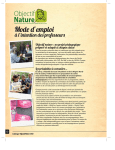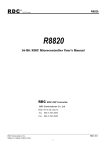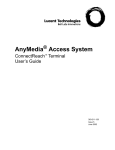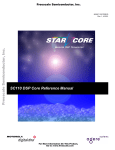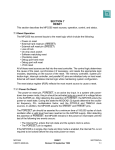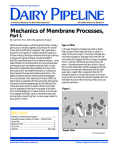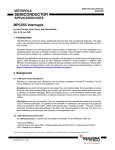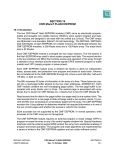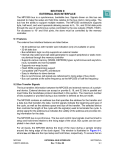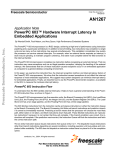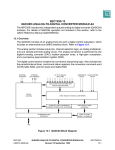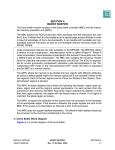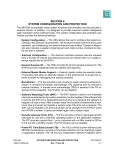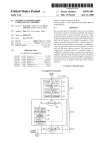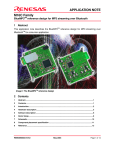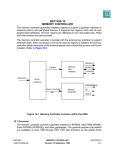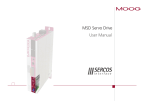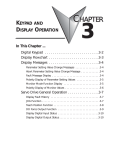Download 11-1
Transcript
SECTION 11 L-BUS TO U-BUS INTERFACE (L2U) The L-bus to U-bus interface unit (L2U) provides an interface between the load/store bus (L-bus) and the unified bus (U-bus). The L2U module includes the data memory protection unit (DMPU), which provides protection for data memory accesses. The L2U is bi-directional. It allows load/store accesses not intended for the L-bus data RAM to go to the U-bus. It also allows code execution from the L-bus data RAM and read/write accesses from the U-bus to the L-bus. The L2U directs bus traffic between the L-bus and the U-bus. When transactions start concurrently on both buses, the L2U interface arbitrates to select which transaction is handled. The top priority is assigned to U-bus to L-bus accesses; lower priority is assigned to the load/store accesses by the RCPU. 11.1 General Features • Non-pipelined master and slave on U-bus — Does not start two back-to-back accesses on the U-bus — Supports the U-bus pipelining by starting a cycle on the U-bus when U-bus pipe depth is zero or one — Does not accept back-to-back accesses from the U-bus master • Non-pipelined master and slave on the L-bus • Generates module selects for L-bus memory-mapped resources within a programmable, contiguous block of storage • Programmable data memory protection unit (DMPU) • L-bus and U-bus snoop logic for PowerPC reservation protocol • L2U does not support dual mapping of L-bus or IMB3 space • Show cycles for RCPU accesses to the SRAM (none, all, writes) — Protection for SRAM accesses from the U-bus side (all accesses to the SRAM from the U-bus side are blocked once the SRAM protection bit is set) 11.2 DMPU Features • Supports four memory regions whose base address and size can be programmed — Available sizes are 4 Kbytes, 8 Kbytes, 16 Kbytes, 32 Kbytes, 64 Kbytes, 128 Kbytes, 256 Kbytes, 512 Kbytes, 1 Mbyte, 2 Mbytes, 4 Mbytes, 8 Mbytes, and 16 Mbytes — Region must start on the specified region size boundary — Overlap between regions is allowed • Each of the four regions supports the following attributes: • Access protection: user or supervisor • Guarded attribute: speculative or non-speculative • Enable/disable option • Read only option MPC555 USER’S MANUAL L-BUS TO U-BUS INTERFACE (L2U) Revised 15 September 1999 MOTOROLA 11-1 • Supports a default global entry for memory space not covered by other regions: — Default access protection — Default guarded attribute • Interrupt generated upon: — Access violation — Load from guarded region — Write to read-only region • The PowerPC MSR[DR] bit (data relocate) controls DMPU protection on/off operation • Programming is done using PowerPC’s mtspr/mfspr instructions to/from implementation specific special purpose registers. • No protection for accesses to the SRAM module on the L-bus (SRAM has its own protection options) 11.3 L2U Block Diagram Figure 11-1 shows a block diagram of the L-bus to U-bus interface. L-bus L-bus Interface Address Reservation Decode Control DMPU U-bus Interface U-bus Figure 11-1 L2U Bus Interface Block Diagram 11.4 Modes Of Operation The L2U Module can operate in the following modes: • Normal Mode • Reset Operation • Factory Test Mode • Peripheral Mode MPC555 USER’S MANUAL L-BUS TO U-BUS INTERFACE (L2U) Revised 15 September 1999 MOTOROLA 11-2 11.4.1 Normal Mode In normal mode (master or slave) the L2U module acts as a bi-directional protocol translator. In master mode the CPU is fully operational, and there is no external master access to the U-bus. Slave mode enables an external master to access any internal bus slave while the CPU is fully operational. The L2U transfers load/store accesses from the RCPU to the U-bus and the read/write accesses by the U-bus master to the L-bus. In addition to the bus protocol translation, the L2U supports other functions such as show cycles, data memory protection and PowerPC reservation protocol. When a load from the U-bus resource or store to the U-bus resource is issued by the RCPU, it is compared against the DMPU region access (address and attribute) comparators. If none of the access attributes are violated, the access is directed to the Ubus by the L2U module. If the DMPU detects an access violation, it informs the error status to the master initiating the cycle. When show cycles are enabled, accesses to all of the L-bus resources by the RCPU are made visible on the U-bus side by the L2U. The L2U is responsible for handling the effects of reservations on the L-bus and the U-bus. For the L-bus and the U-bus, the L2U detects reservation losses and updates the RCPU core with the reservation status. 11.4.2 Reset Operation Upon soft reset assertion, the L2U goes to an idle state and all pending accesses are ignored. The L2U module control registers are not initialized on the assertion of a soft reset, keeping the system configuration unchanged. Upon assertion of hard reset, the L2U control registers are initialized to their reset states. While reset (hard or soft) is asserted on the U-bus, the L2U asserts the corresponding L-bus reset signals. The L2U also drives the reset configuration word from the U-bus to the L-bus upon assertion of hard reset. 11.4.3 Factory Test Mode Factory test mode is a special mode of operation that allows access to the internal modules for testing. This mode is not intended for general use and is not supported for normal applications. 11.4.4 Peripheral Mode In the peripheral mode of operation the RCPU is shut down and an alternative master on the external bus can perform accesses to any internal bus (U-bus and L-bus) slave. The external master can also access the internal PowerPC special registers that are located in L2U. In order to access one of these PowerPC registers the EMCR[CONT] bit in the USIU must be cleared. MPC555 USER’S MANUAL L-BUS TO U-BUS INTERFACE (L2U) Revised 15 September 1999 MOTOROLA 11-3 11.5 Data Memory Protection The data memory protection unit (DMPU) in the L2U module provides access protection for the memory regions on the U-bus side from load/store accesses by the RCPU. (Only U-bus space is protected.) The DMPU does not protect PowerPC register accesses initiated by the RCPU on the L-bus. The user can assign up to four regions of access protection attributes and can assign global attributes to any space not included in the active regions. When it detects an access violation, the L2U generates an exception request to the CPU. Access attribute Address Region0 Address and size Region1 Address and size Region2 Address and size Region3 Address and size Match select Region0 protection/attribute Region1 protection/attribute Region2 protection/attribute Region3 protection/attribute Global protection/attribute Specific Error Interrupts to Core RegionProtection/Attribute MSRDR Exception Logic ACCESS GRANTED Figure 11-2 DMP Basic Functional Diagram 11.5.1 Functional Description Data memory protection is assigned on a regional basis. Default manipulation of the DMPU is done on a global region. The DMPU has control registers which contain the following information: region protection on/off, region base address, region size, and the region’s access permissions. Each region’s protection attributes can be turned on/ off by configuring the enable attribute bit (ENRx) located in the global region attribute register. During each load/store access from the RCPU core to the U-bus, the address is compared to the value in the region base address register of each enabled region. Any access that matches the specific region within its appropriate size, as defined by the region size field (RS) of the region attribute register, sets a match indication. MPC555 USER’S MANUAL L-BUS TO U-BUS INTERFACE (L2U) Revised 15 September 1999 MOTOROLA 11-4 When more than one match indication occurs, the effective region is the region with the highest priority. Priority is determined by region number; highest priority corresponds to the lowest region number. When no match occurs, the effective region is the global region. The global region has the lowest priority. The region attribute register also contains the region’s protection fields. The protection field (PP) of the effective region is compared to the access attributes. If the attributes match, the access is permitted. When the access is permitted, a U-bus access may be generated according to the specific attribute of the effective region. When the access by the RCPU is not permitted, the L2U module asserts a data memory storage exception to the RCPU. For speculative load/store accesses from the RCPU to a region marked as guarded (G bit of region attribute register is set), the L2U asks the RCPU to retry the L-bus cycle until either the access is not speculative, or it is canceled by the RCPU. In the case of attempted accesses to a guarded region together with any other protection violation (no access), the L2U retries the access. The L2U handles this event as a data storage violation only when the access becomes non-speculative. Note that access protection is active only when the PowerPC’s MSR[DR] = 1. When MSR[DR] = 0, DMPU exceptions are disabled, all accesses are considered to be to a guarded memory area, and no speculative accesses are allowed. In this case, if the Lbus master [RCPU] initiates a non-SRAM cycle (access through the L2U) that is marked speculative, the L2U asks the RCPU to retry the L-bus cycle until either the access is not speculative, or it is canceled by the RCPU Core. Note that the programmer must not overlap the SRAM memory space with any enabled region. Overlapping an enabled region with SRAM memory space disables the L2U data memory protection for that region. If an enabled region overlaps with the L-bus space, the DMPU ignores all accesses to addresses within the L-bus space. If an enabled region overlaps with PowerPC register addresses, the DMPU ignores any access marked as a PowerPC access. 11.5.2 Associated Registers The following registers are used to control the DMPU of the L2U module. All the registers are special purpose registers which are accessed via the PowerPC mtspr/ mfspr instructions. The registers are also accessed by an external master when EMCR[CONT] = 0. See 11.8 L2U Programming Model for register diagrams and bit descriptions. MPC555 USER’S MANUAL L-BUS TO U-BUS INTERFACE (L2U) Revised 15 September 1999 MOTOROLA 11-5 . Table 11-1 DMPU Registers Name Description L2U_RBA0 Region Base Address Register 0 L2U_RBA1 Region Base Address Register 1 L2U_RBA2 Region Base Address Register 2 L2U_RBA3 Region Base Address Register 3 L2U_RA0 Region Attribute Register 0 L2U_RA1 Region Attribute Register 1 L2U_RA2 Region Attribute Register 2 L2U_RA3 Region Attribute Register 3 L2U_GRA Global Region Attribute CAUTION The appropriate DMPU registers must be programmed before the MSR[DR] bit is set. Otherwise, DMPU operation is not guaranteed. Program the region base address in the L2U_RBAx registers to the lower boundary of the region specified by the corresponding L2U_RAx[RS] field. If the region base address does not correspond to the boundary of the block size programmed in the L2U_RAx, the DMPU snaps the region base to the lower boundary of that block. For example, if the block size is programmed to 16 Kbytes for region zero (i.e. L2U_RA0[RS] = 0 x 3) and the region base address is programmed to 0x1FFF(i.e., L2U_RBA0[RBA] = 0 x 1), then the effective base address of region zero is 0 x 0. See Figure 11-3. 0x00000000 region 0 (16 Kbytes) Resulting Region 0x00001FFF Actual Programmed Region 0x00003FFF 0x00005FFF Figure 11-3 Region Base Address Example MPC555 USER’S MANUAL L-BUS TO U-BUS INTERFACE (L2U) Revised 15 September 1999 MOTOROLA 11-6 It is the user’s responsibility to program only legal region sizes. The L2U does not check whether the value is legal. If the user programs an illegal region size, the region calculation may not be successful. 11.5.3 L-bus Memory Access Violations All L-bus slaves have their own access protection logic. For consistency, all storage access violations have the same termination result. Thus access violations for load/ store accesses started by the RCPU always have the same termination from all slaves: assertion of the data storage exception. All other L-bus masters cause machine check exceptions. 11.6 Reservation Support The RCPU storage reservation protocol supports a multi-level bus structure. For each local bus, storage reservation is handled by the local reservation logic. The protocol tries to optimize reservation cancellation such that a PowerPC processor (RCPU) is notified of storage reservation loss on a remote bus (U-bus, IMB or external bus) only when it has issued a stwcx cycle to that address. That is, the reservation loss indication comes as part of the stwcx cycle. 11.6.1 The Reservation Protocol The reservation protocol operates under the following assumptions: • Each processor has at most 1 reservation flag • A lwarx instruction sets the reservation flag • Another lwarx instruction by same processor clears the reservation flag related to a previous lwarx instruction and sets again the reservation flag • A stwcx instruction by same processor clears the reservation flag • A store instruction by same processor does not clear the reservation flag • Some other processor (or other mechanism) store to an address with an existing reservation clears the reservation flag • In case the storage reservation is lost, it is guaranteed that stwcx will not modify the storage 11.6.2 L2U Reservation Support The L2U is responsible for handling the effects of reservations on the L-bus and the U-bus. For the L-bus and the U-bus, the L2U detects reservation losses. The reservation logic in the L2U performs the following functions: • Snoops accesses to all L-bus and U-bus slaves • Holds one reservation (address) for the core • Sets the reservation flag when the CPU issues a load-with-reservation request The unit for reservation is one word. A byte or half-word store request by another master will clear the reservation flag. MPC555 USER’S MANUAL L-BUS TO U-BUS INTERFACE (L2U) Revised 15 September 1999 MOTOROLA 11-7 A load-with-reservation request by the CPU updates the reservation address related to a previous load-with-reservation request and sets the reservation flag for the new location. A store-with-reservation request by the CPU clears the reservation flag. A store request by the CPU does not clear the flag. A store request by some other master to the reservation address clears the reservation flag. If the storage reservation is lost, it is guaranteed that a store-with-reservation request by the CPU will not modify the storage. The L2U does not start a store-with-reservation cycle on the U-bus if the reserved location on the U-bus has been touched by another master. The L2U drives the reservation status back to the core. When the reserved location in the SRAM on the L-bus is touched by an alternate master, on the following clock, the L2U indicates to the CPU that the reservation has been touched. On assertion of the cancel-reservation signal, the RCPU clears the internal reservation bit. If an stwcx cycle has been issued at the same time, the RCPU aborts the cycle. Storage reservation is set regardless of the termination status (address or data phase) of the lwarx access. Storage reservation is cleared regardless of the data phase termination status of the stwcx access if the address phase is terminated normally. Storage reservation will be cleared regardless of the data phase termination status of the write requests by another master to the reserved address if the address phase of the write access is terminated normally on the destination (U-bus/L-bus) bus. If the programmable memory map of the part is modified between a lwarx and a stwcx instruction, the reservation is not guaranteed. 11.6.3 Reserved Location (Bus) and Possible Actions Once the CPU core reserves a memory location, the L2U module is responsible for snooping L-bus and U-bus for possible intrusion of the reserved location. Under certain circumstances, the L2U depends on the USIU or the UIMB to provide status of reservation on external bus and the IMB3 respectively. Table 11-2 lists all reservation protocol cases supported by the L2U snooping logic. MPC555 USER’S MANUAL L-BUS TO U-BUS INTERFACE (L2U) Revised 15 September 1999 MOTOROLA 11-8 Table 11-2 Reservation Snoop Support Reserved Location On Intruding Alternate Master L-bus L-Master Request to cancel the reservation.1 U-Master Request to cancel the reservation. L-Master Block stwcx2 U-Master Block stwcx L-Master Block stwcx U-Master Block stwcx U-bus External Bus Ext-Master IMB3 Action Taken on stwcx cycle Transfer Status3 L-Master Block stwcx U-Master Block stwcx IMB3-Master Transfer Status NOTES: 1. If the RCPU tries to modify (stwcx) that location, the L2U does not have enough time to stop the write access from completing. In this case, the L2U will drive cancel-reservation signal back to the core as soon as it comes to know that the alternate master on the U-bus has touched the reserved location. 2. If the RCPU tries to modify (stwcx) that location, the L2U does not start the cycle on the U-bus and it communicates to the core that the current write has been aborted by the slave with no side effects. 3. If the RCPU tries to modify (stwcx) that location, the L2U runs a write-cycle-with-reservation request on the U-bus. The L2U samples the status of the reservation along with the U-bus cycle termination signals and it communicates to the core if the current write has been aborted by the slave with no side effects. 11.7 L-Bus Show Cycle Support The L2U module provides support for L-bus show cycles. L-bus show cycles are external visibility cycles that reflect activity on the L-bus that would otherwise not be visible to the external bus. L-bus show cycles are software controlled. 11.7.1 Programming Show Cycles L-bus show cycles are disabled during reset and must be configured by writing the appropriate bits in the L2U_MCR control register. L-bus show cycles are programmed by setting the LSHOW[0:1] bits in the L2U_MCR. The Table 11-3 shows the configurations of the LSHOW[0:1] bits. Table 11-3 L2U_MCR LSHOW Modes LSHOW Action 00 Disable L-bus show cycles 01 Show address and data of all L-bus space write cycles 10 Reserved (Disable L-bus show cycles) 11 Show address and data of all L-bus space read and write cycles 11.7.2 Performance Impact When show cycles are enabled in the L2U module, there is a performance penalty on the L-bus. This occurs because the L2U module does not support more than one access being processed at any time. To ensure that only one access at a time can be MPC555 USER’S MANUAL L-BUS TO U-BUS INTERFACE (L2U) Revised 15 September 1999 MOTOROLA 11-9 processed, and not lose an L-bus access that would have been show cycled, the L2U module will arbitrate for the L-bus whenever it is processing any access. This L-bus arbitration will prevent any other L-bus master from starting a cycle that might turn out to be a qualifiable L-bus show cycle. For L-bus show cycles, the minimum performance impact on the L-bus will be three clocks. This minimum impact assumes that the L-bus slave access is a 1-clock access, and the L2U module acquires immediate bus grant on the U-bus. The L2U has to wait two clocks before completing the show cycle on the U-Bus, thus using up five clocks for the complete process. A retried access on the L-bus (no address acknowledge) that qualifies to be show cycled, will be accepted when it is actually acknowledged. This will cause a 1-clock delay before an L-bus master can retry the access on the L-bus, because the L2U module will release L-bus one clock later. L2U asserts the internal bus request signal on the U-bus for a minimum of two clocks when starting a show cycle on the U-bus. 11.7.3 Show Cycle Protocol The L2U module behaves as both a master and a slave on the U-bus during show cycles. The L2U starts the U-bus transfer as a a bus master and then completes the address phase and data phase of the cycle as a slave. The L2U follows U-bus protocol of in-order termination of the data phase. The USIU can control the start of show cycles on the U-bus by asserting the no-show cycle indicator. This will cause the L2U module to release the U-bus for at least one clock before retrying the show cycle. 11.7.4 L-Bus Write Show Cycle Flow The L2U performs the following sequence of actions for an L-bus-write show cycle. 1. Arbitrates for the L-bus to prevent any other L-bus cycles from starting 2. Latches the address and the data of the L-bus access, along with all address attributes 3. Waits for the termination of the L-bus access and latches the termination status (data error) 4. Arbitrate for the U-bus, and when granted, starts the U-bus access, asserting show cycle request on the U-bus, along with address, attributes and the write data. The L2U module provides address recognize and acknowledgment for the address phase. If the no-show cycle indicator from the U-bus is asserted, the L2U does not start the show cycle. The L2U module releases the U-bus until the no-show cycle indicator is negated and then arbitrates for the U-bus again. 5. When the L2U module has U-bus data bus grant, it drives the data phase termination handshakes on the U-bus. 6. Releases the L-bus MPC555 USER’S MANUAL L-BUS TO U-BUS INTERFACE (L2U) Revised 15 September 1999 MOTOROLA 11-10 11.7.5 L-Bus Read Show Cycle Flow The L2U performs the following sequence of actions for an L-bus read show cycle. 1. Arbitrates for the L-bus to prevent any other L-bus cycle from starting 2. Latches the address of the L-bus access, along with all address attributes 3. Waits for the data phase termination on the L-bus and latch the read data, and the termination status from the L-bus 4. Arbitrate for the U-bus, and when granted, starts the U-bus access, asserting the show cycle request on the U-bus, along with address attributes. The L2U module provides address recognize/acknowledgment for the address phase. If the no-show cycle indicator from the U-bus is asserted, the L2U does not start the show cycle. The L2U module releases the U-bus until the no-show cycle indicator is negated and then arbitrates for the U-bus again. 5. When the L2U module has U-bus data bus grant, it drives the read data and the data phase termination handshakes on the U-bus 6. Release the L-bus. 11.7.6 Show Cycle Support Guidelines The following are the guidelines for L2U show cycle support: • The L2U module provides address and data for all qualifying L-bus cycles when the appropriate mode bits are set in the L2U_MCR. • The L2U-module-only show cycles L-bus activity that is not targeted for the U-bus or the L2U module internal registers, irrespective of the termination status of such activity. • The L2U module does not show cycle any access to a PowerPC special purpose register. • The L2U does not start a show cycle for an L-bus access that is retried. This decision to not start the show cycle causes a clock delay before the cycle can be retried, since the L2U module will have arbitrated away the L-bus immediately on detecting the show cycle, before the retry information is available. • The L2U module does not show cycle any L-bus activity that is aborted. • The L2U module backs off the U-bus if the USIU inhibits show cycle activity on the U-bus. • The L2U does not show cycle any L-bus addresses that fall in the L-bus SRAM address space if the SRAM Protection [SP] bit is set in the L2U_MCR. Table 11-4 summarizes the L2U show cycle support. MPC555 USER’S MANUAL L-BUS TO U-BUS INTERFACE (L2U) Revised 15 September 1999 MOTOROLA 11-11 Table 11-4 L2U Show Cycle Support Chart Case Destination LB AACK LB ABORT Comments 1 L-bus Slave1 No X Not show cycled [Cycle will be retried one clock later]4 2 L2U 2 X X Not show cycled X X Not show cycled 3 3 U-bus/E-bus 4 L-bus slave Yes No Show cycled 5 L-bus slave Yes Yes Not show cycled [L-bus will be released next clock] 1. L-bus slave includes all address in the L-bus address space. 2. L2U indicates L2U registers. 3. U-bus/E-bus refers to all destinations through the L2U interface. 4. There will be a 1-clock turnaround because the L-bus retry information is not available in time to negate the Lbus arbitration. Note: X indicates don’t care conditions. 11.8 L2U Programming Model The L2U control registers control the L2U bus interface and the DMPU. They are accessible via the MPC555 mtspr and mfspr instructions. They are also accessible by an external master when EMCR[CONT] bit is cleared. L2U control registers are accessible from both the L-bus side and the U-bus side in one clock cycle. As with all SPRs, L2U registers are accessible in supervisor mode only. Any unimplemented bits in L2U registers return 0’s on a read, and the writes to those register bits are ignored. The Table 11-5 shows L2U registers along with their SPR numbers and hexadecimal addresses which are used to access L2U registers during a peripheral mode access. . Table 11-5 L2U (PPC) Register Decode Name SPR # SPR5:9 SPR0:4 Address for External Master Access Access Description L2U_MCR 568 10001 11000 0x0000_3110 SUPR L2U Module Configuration Register L2U_RBA0 792 11000 11000 0x0000_3180 SUPR Region Base Address Register 0 L2U_RBA1 793 11000 11001 0x0000_3380 SUPR Region Base Address Register 1 L2U_RBA2 794 11000 11010 0x0000_3580 SUPR Region Base Address Register 2 L2U_RBA3 795 11000 11011 0x0000_3780 SUPR Region Base Address Register 3 L2U_RA0 824 11001 11000 0x0000_3190 SUPR Region Attribute Register 0 L2U_RA1 825 11001 11001 0x0000_3390 SUPR Region Attribute Register 1 L2U_RA2 826 11001 11010 0x0000_3590 SUPR Region Attribute Register 2 L2U_RA3 827 11001 11011 0x0000_3790 SUPR Region Attribute Register 3 L2U_GRA 536 10000 11000 0x0000_3100 SUPR Global Region Attribute For these registers a bus cycle will be performed on the L-bus and the U-bus with the address as shown inTable 11-6. MPC555 USER’S MANUAL L-BUS TO U-BUS INTERFACE (L2U) Revised 15 September 1999 MOTOROLA 11-12 . Table 11-6 Hex Address For SPR Cycles A0:17 A18:22 A23:27 A28:31 0 spr0:4 spr5:9 0 11.8.1 U-bus Access The L2U registers are accessible from the U-bus side only if it is a supervisor mode data access and the register address is correct and it is indicated on the U-bus that it is a PPC register access. A user mode access, or an access marked as instruction, to L2U registers from the Ubus side will cause a data error on the U-bus. 11.8.2 Transaction Size All L2U registers are defined by PowerPC architecture as being 32-bit registers. There is no PowerPC instruction to access either a half word or a byte of the special purpose register. All L2U registers are only word accessible (read and write) in peripheral mode. A half-word or byte access in peripheral mode will result in a word transaction. 11.8.3 L2U Module Configuration Register (L2U_MCR) The L2U module configuration register (L2U_MCR) is used to control the L2U module operation. L2U_MCR — L2U Module Configuration Register MSB 0 SP 1 2 3 4 5 6 7 8 LSHOW SPR 568 9 10 11 12 13 14 15 RESERVED RESET: 0 0 0 0 0 0 0 0 0 0 0 0 0 0 0 0 16 17 18 19 20 21 22 23 24 25 26 27 28 29 30 LSB 31 0 0 0 0 0 0 0 RESERVED RESET: 0 0 0 MPC555 USER’S MANUAL 0 0 0 0 0 0 L-BUS TO U-BUS INTERFACE (L2U) Revised 15 September 1999 MOTOROLA 11-13 Table 11-7 L2U_MCR Bit Settings Bit(s) Name Description SRAM Protection (SP) bit is used to protect the SRAM on the L-bus from U-bus accesses. This bit can be set or cleared from the L-bus side. It can be set or cleared from the U-bus side when factory test mode is enabled. When not in factory test mode, any attempt to set or clear the SP bit from the U-bus side has no affect. 0 SP Once this bit is set, the L2U blocks all SRAM accesses initiated by the U-bus masters and the access is terminated with a data error on the U-bus. If L-bus show cycles are enabled, setting this bit will disable L-bus SRAM show cycles. 1:2 LSHOW 3:31 — LSHOW bits are used to configure the show cycle mode for cycles accessing the L-bus slave e.g. SRAM 00 = Disable show cycles 01 = Show address and data of all L-bus space write cycles 10 = Reserved 11 = Show address and data of all L-bus space read and write cycles Reserved 11.8.4 Region Base Address Registers (L2U_RBAx) The region base address register defines the base address of a specific region protected by the data memory protection unit. There are four registers (x = 0...3), one for each supported region. L2U_RBAx — L2U Region x Base Address Register MSB 0 1 2 3 4 5 6 7 SPR 792 – 795 8 9 10 11 12 13 14 15 RBA RESET: x x x x x x x x x x x x x x x x 16 17 18 19 20 21 22 23 24 25 26 27 28 29 30 LSB 31 0 0 0 0 0 RBA RESERVED RESET: x x x x 0 0 0 0 0 0 0 x = Undefined Table 11-8 L2U_RBAx Bit Settings Bit(s) Name Description 0:19 RBA Region base address. The RBA field provides the base address of the region. The region base address should start on the block boundary for the corresponding block size attribute specified in the region attribute register (L2U_RAx). 20:31 — MPC555 USER’S MANUAL Reserved L-BUS TO U-BUS INTERFACE (L2U) Revised 15 September 1999 MOTOROLA 11-14 11.8.5 Region Attribute Registers (L2U_RAx) Each region attribute register defines the protection attributes associated with a specific region protected by the data memory protection unit. There are four registers (x = 0...3), one for each supported region. L2U_RAx — L2U Region X Attribute Register MSB 0 1 2 3 4 5 6 7 SPR 824 – 827 8 9 10 11 RESERVED 12 13 14 15 RS RESET: 0 0 0 0 0 0 0 0 0 0 0 0 0 0 0 0 16 17 18 19 20 21 22 23 24 25 26 27 28 29 30 LSB 31 0 0 RS PP RESERVED G RESERVED RESET: 0 0 0 0 0 0 0 0 0 0 0 0 0 0 Table 11-9 L2U_RAx Bit Settings Bit(s) Name 0:7 — Reserved RS Region size 0000_0000_0000 = 4 Kbytes 0000_0000_0001 = 8 Kbytes 0000_0000_0011 = 16 Kbytes 0000_0000_0111 = 32 Kbytes 0000_0000_1111 = 64 Kbytes 0000_0001_1111 = 128 Kbytes 0000_0011_1111 = 256 Kbytes 0000_0111_1111 = 512 Kbytes 0000_1111_1111 = 1 Mbyte 0001_1111_1111 = 2 Mbytes 0011_1111_1111 = 4 Mbytes 0111_1111_1111 = 8 Mbytes 1111_1111_1111 = 16 Mbytes 20:21 PP Protection bits 00 = No supervisor access, no user access 01 = Supervisor read/write access, no user access 10 = Supervisor read/write access, user read-only access 11 = Supervisor read/write access, user read/write access 22:24 — Reserved 25 G Guarded attribute 0 = Not guarded from speculative accesses 1 = Guarded from speculative accesses 26:31 — Reserved 8:19 Description 11.8.6 Global Region Attribute Register The global region attribute register defines the protection attributes associated with the memory region which is not protected under the four DMPU regions. This register also provides enable/disable control for the four DMPU regions. MPC555 USER’S MANUAL L-BUS TO U-BUS INTERFACE (L2U) Revised 15 September 1999 MOTOROLA 11-15 L2U_GRA — L2U Global Region Attribute Register MSB 0 1 2 3 4 5 6 7 8 SPR 536 9 ENR0 ENR1 ENR2 ENR3 10 11 12 13 14 15 RESERVED RESET: 0 0 0 0 0 0 0 0 0 0 0 0 0 0 0 0 16 17 18 19 20 21 22 23 24 25 26 27 28 29 30 LSB 31 0 0 RESERVED PP RESERVED G RESERVED RESET: 0 0 0 0 0 0 0 0 0 0 0 0 0 0 Table 11-10 L2U_GRA Bit Settings Bit(s) Name 0 ENR0 Enable attribute for region 0 0 = Region attribute is off 1 = Region attribute is on 1 ENR1 Enable attribute for region 1 0 = Region attribute is off 1 = Region attribute is on 2 ENR2 Enable attribute for region 2 0 = Region attribute is off 1 = Region attribute is on 3 ENR3 Enable attribute for region 3 0 = Region attribute is off 1 = Region attribute is on 4:19 — Reserved 20:21 PP Protection bits 00 = No supervisor access, no user access 01 = Supervisor read/write access, no user access 10 = Supervisor read/write access, user read-only access 11 = Supervisor read/write access, user read/write access 22:24 — Reserved 25 G Guarded attribute 0 = Not guarded from speculative accesses 1 = Guarded from speculative accesses 26:31 — Reserved MPC555 USER’S MANUAL Description L-BUS TO U-BUS INTERFACE (L2U) Revised 15 September 1999 MOTOROLA 11-16

















